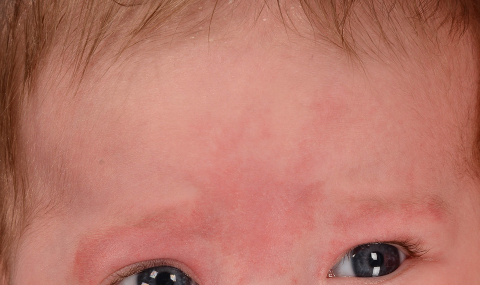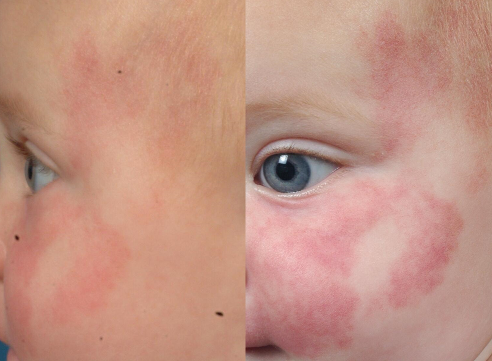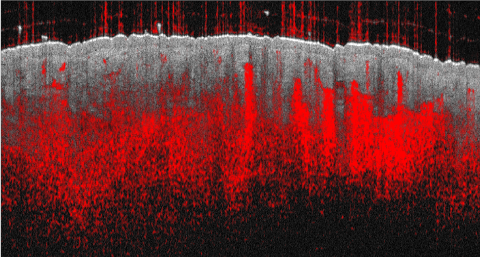Capillary Malformation / Port Wine Stain
Capillary malformation, often called ‘Port-wine Stain’ is a common condition in which an area of skin is more red in color than normal.
Introduction
|
In our skin, we have capillaries. These are the smallest of all blood vessels, measuring about a tenth of the thickness of a human hair, and the blood flowing through these capillaries gives our skin its pink color. In capillary malformation, the capillaries of a patch of skin are larger than normal. Because the capillaries are formed larger, they have more blood in them and so the skin has a redder color in these areas. Capillary malformation is common, affecting about 1 in 300 people, and girls are 3 times as likely to have a capillary malformation than boys.
It is important to realize that not all red patches on babies’ skin are capillary malformation. Over half of all children born have a red patch on their face, often between the eyebrows, or on their neck, around the hairline. These are called macular stains, or more commonly: Angel’s Kiss or Stork Bite. They can look very similar to capillary malformation in the first few weeks after birth but they fade gradually over a year or two. This photograph is an example of a macular stain in the glabellar area of the forehead: Capillary malformation can be anywhere on the body but it is found most often on the face. Unlike a macular stain, it doesn’t fade but instead becomes darker and more red over the first few months. Here is a girl with a capillary malformation of the cheek soon after birth and again a few months afterwards, when the capillary malformation has become darker:
If capillary malformation isn’t treated, it will continue to darken through childhood and untreated capillary malformation often ends up as a dark purple patch of skin. It often has a thick and lumpy surface, and can cause overgrowth of the affected area. The main aims of treatment are to avoid these changes developing over time, and to minimze the aesthetic impact of the red skin color.
|
Interesting Fact:
Port-Wine Stain is named after the dark red alcoholic beverage Porto, made in northern Portugal from red wine and brandy - as it was the most popular type of wine in Britain between 1700 and 1940.
|
Treatment
Treatment is recommended for capillary malformation in the first few years of life, while the skin is still pink to red. The aim of treatment is to shrink the enlarged capillaries so that the skin holds just the normal amount of blood and has a color similar to the child's unaffected skin. This is usually done using light therapy, most often using a Vascular LASER. Laser therapy involves shining pulses of a particular color of light onto the skin. The color is chosen so that the energy of the light is absorbed by the hemoglobin in the blood, which gives our blood its red color, and the hemoglobin heats up. This heat causes some damage to the inside wall of the enlarged capillaries, and as a result they shrink and the skin becomes less red.
There are several pulsed light devices that we use for capillary malformation at Children's Health. Most often, we use a KTP laser, but we also have pulsed-dye and Nd:YAG lasers, as well as an Intense Pulsed Light device that we use for capillary malformations when needed. We routinely use cooling to help protect the skin during these treatments.
There are several pulsed light devices that we use for capillary malformation at Children's Health. Most often, we use a KTP laser, but we also have pulsed-dye and Nd:YAG lasers, as well as an Intense Pulsed Light device that we use for capillary malformations when needed. We routinely use cooling to help protect the skin during these treatments.
Special Considerations
Patients with capillary malformation affecting the upper face have a 1 in 10 chance of also having a condition known as Sturge-Weber Syndrome. In Sturge-Weber Syndrome, the capillary malformation in the skin of the face is associated with other malformations of blood vessels in the eye and around the brain, which can cause glaucoma, seizures and other neurological problems. Patient with facial capillary malformation should be evaluated for Sturge-Weber Syndrome, usually with a brain MRI scan and monitoring of eye pressures: either to be able to reassure patients and parents, or to direct them to the appropriate services to mimimize the consequences of this disease.
Current Research
When we use vascular lasers for capillary malformation, there is often excellent fading of the red area with the first few treatments, but once it has faded to a light pink, the improvement is less predictable. This is likely because the blood vessels in the capillary malformation are out of reach of the laser light, which only travels about 1mm into the skin. We are looking at where the blood vessels are in the skin, and how the position changes with laser treatments. By using a technology called Optical Coherence Tomography (OCT), we can examine the blood flow in various levels of the skin and hope to use this information to help choose the type of laser, and the ideal laser settings to give the best outcome from each treatment. The OCT scans are similar to a 5-second video recording using a close-up camera, are completely painless, and provide images such as this with the structure of the skin in gray, and the blood flow in red:




